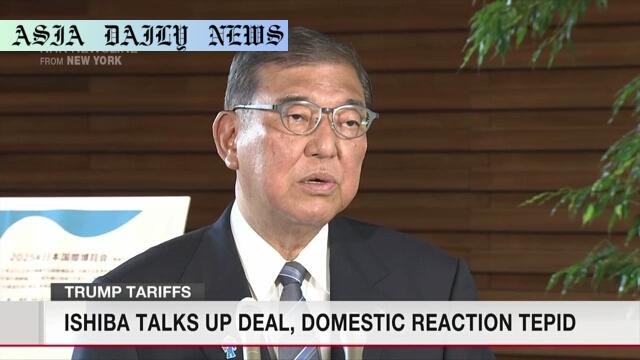Tariff Deal: Japan PM Ishiba emphasizes Tokyo’s achievements in securing a beneficial tariff deal with the United States.
Japan and the US have reached a historic tariff deal, halving US auto tariffs from 25% to 12.5%.
Prime Minister Ishiba highlighted the mutually beneficial nature of the agreement and Japan’s success in avoiding quotas.
Opposition leaders expressed concerns over the new 15% tariff rate being six times the previous rate.
Japan plans rapid implementation, including supporting domestic industries through detailed tariff information and consultation.

Introduction to the Japan-US Tariff Deal
The recent tariff agreement between Japan and the United States marks a pivotal development in international trade. Japanese Prime Minister Ishiba Shigeru lauded the deal as a milestone achievement that safeguards key Japanese interests while maintaining bilateral economic cooperation. Announced after a meeting between Japan’s Economic Revitalization Minister Akazawa Ryosei and US President Donald Trump, the agreement reduces US-imposed automobile tariffs from 25% to 12.5%, doubling to 15% when combined with existing US duties.
The deal represents a strategic victory for Japan, allowing it to avoid potentially damaging auto-export quotas. For Japan, securing tariff reductions ahead of other nations showcases its negotiating prowess on the global stage. This initiative is part of Prime Minister Ishiba’s larger economic agenda aimed at fostering growth and protecting domestic employment in the automotive sector.
Reactions and Concerns
While the agreement brings notable benefits, it has also sparked concerns within Japan. Noda Yoshihiko, leader of the opposition Constitutional Democratic Party of Japan, pointed out that the new 15% tariff is six times higher than pre-April rates. Critics worry about its long-term repercussions on Japanese export competitiveness. Nonetheless, government officials and industry leaders emphasized the importance of aggressively mitigating these effects through domestic reforms and targeted support strategies.
The Japanese government plans to focus on publishing detailed tariff rates and providing specialized consultation services to affected sectors. This proactive approach aims to reassure stakeholders and sustain economic activity amidst the shifting trade landscape. Additionally, Prime Minister Ishiba is set to meet with other political leaders to discuss the details and implications of the deal, ensuring transparency.
Long-Term Implications
The success of this tariff deal will not only depend on its immediate economic outcomes but also on Japan’s ability to navigate shifting global trade dynamics. The agreement potentially paves the way for deeper cooperation between Japan and the United States, reinforcing their long-standing alliance in a highly competitive international market.
Furthermore, the move has wide-reaching implications beyond the automotive industry. As nations worldwide grapple with fluctuating trade policies, Japan’s success in securing advantageous terms underscores the importance of skillful diplomacy. It sets a precedent for other Asian economies looking to safeguard their interests in global trade.
Final Thoughts
As with any major trade arrangement, the true value of this agreement lies in its implementation and impact on both economies. By striking a balance between protectionism and free trade, Japan has demonstrated its commitment to economic resilience. However, addressing opposition concerns and maintaining public confidence will be crucial as the deal progresses towards realization. Ultimately, the Japan-US tariff agreement serves as a testament to the intricate dance of negotiation in the modern global economy.



Commentary
Recognizing Diplomatic Success
Japan’s recent tariff deal with the United States showcases Prime Minister Ishiba Shigeru’s ability to navigate the complex waters of international trade diplomacy. Securing a 15% tariff rate, particularly under the current global economic climate and protectionist tendencies, reflects a nuanced understanding of bilateral priorities and compromises. This agreement not only protects the vital Japanese auto industry from catastrophic export quotas but also underscores Japan’s commitment to fostering sustainable economic relationships with key trade partners like the United States.
Understanding the Challenges
Despite its celebrated advantages, the deal undoubtedly poses challenges for Japan. The higher tariff rates may strain smaller automobile businesses or those that rely heavily on exports, demanding swift and targeted government interventions. Opposition voices, particularly those of politicians like Noda Yoshihiko, underline these potential drawbacks, reminding the government to stay vigilant and responsive to the deal’s domestic implications. However, such criticisms can also act as constructive checks, ensuring that Japan addresses these concerns with careful planning and flexibility.
Looking Forward: Impacts on Global Trade
This agreement carries broader significance for global trade dynamics. As one of the leading economies in Asia, Japan’s ability to negotiate a balanced tariff reduction reflects its importance in the world stage. The deal sets an example for other nations looking to protect their economic sectors in a rapidly shifting trade environment. Furthermore, it sends a clear message about the value of collaboration over unilateral action in resolving disputes.
Ultimately, while challenges remain, this agreement highlights the potential for economic policies to promote mutual growth and stability. It will be fascinating to observe how this partnership shapes future trade deals between other global powers.